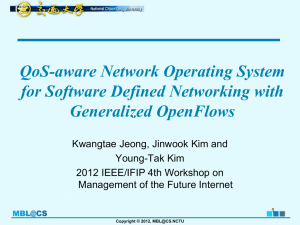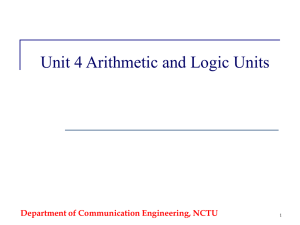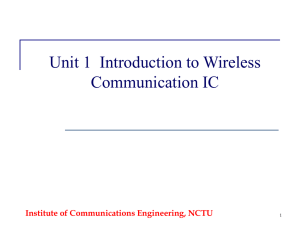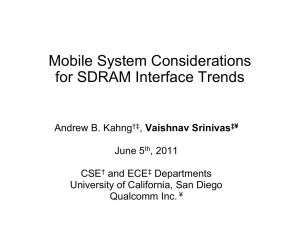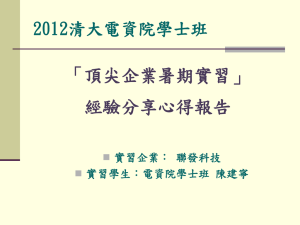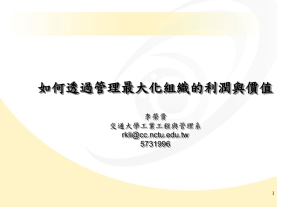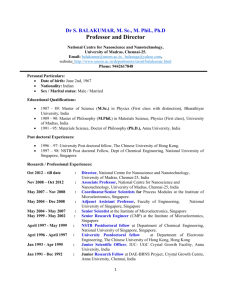Slide
advertisement
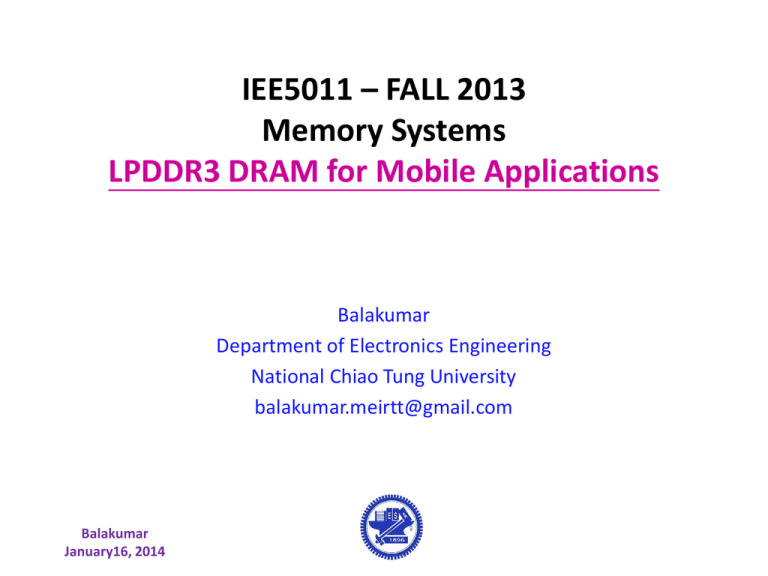
IEE5011 – FALL 2013 Memory Systems LPDDR3 DRAM for Mobile Applications Balakumar Department of Electronics Engineering National Chiao Tung University balakumar.meirtt@gmail.com Balakumar January16, 2014 Outline Motivation PC Like Performance Mobile DRAM Evolutionary Path LPDDRx (Across generations) LPDDR3 ISM (Inner Stack Memory Module) Comparison with Wide I/O Samsung LPDDR3 Conclusion Balakumar January16, 2014 NCTU IEE5011 Memory Systems 2013 2 Motivation Energy efficiency is the major optimization criteria for systems-on-chip (SoCs) for mobile devices (smartphones and tablets). Performance and power consumption of DRAMs (LPDDRs) depends on the configuration of system level parameters, such as operating frequency, interference bandwidth, request size, and memory map. Balakumar January16, 2014 NCTU IEE5011 Memory Systems 2013 3 What is PC-Like Memory Performance Memory implementation by manufacturer Number of bits in DRAM interface/interface data rate Computer Type Price Range Company 1 Tablet / Small $300-$500 64/800** Thin % Light $500-$700 64/1600 Entry Laptop $450-$500 Power Laptop Company 3 Company 4 Company 5 128/800* * 128/ 1333** 128/800** 64/1600 64/ 1333** 64/1333** 64/1333 128/1333 128/ 1333** 128/1333 $1250$1500 128/1600 ** 128/1600 128/ 1333** 128/1600 Entry Desktop $275-$330 64/1600 64/1600 128/ 1333* 64/1333 Power Desktop $1200$2500 256/1333 256/1600 128/ 1333** 128/1600 Balakumar January16, 2014 Company 2 128/1600 192/1333 NCTU IEE5011 Memory Systems 2013 4 Common PC Configurations Balakumar January16, 2014 NCTU IEE5011 Memory Systems 2013 5 System Performance Trend (PC vs Smartphone) Balakumar January16, 2014 NCTU IEE5011 Memory Systems 2013 6 Mobile DRAM Evolution Balakumar January16, 2014 NCTU IEE5011 Memory Systems 2013 7 Future Mobile DRAM Positioning Balakumar January16, 2014 NCTU IEE5011 Memory Systems 2013 8 MDRAM will Exceed PC DRAM Performance Balakumar January16, 2014 NCTU IEE5011 Memory Systems 2013 9 Mobile DRAM Density Requirement Balakumar January16, 2014 NCTU IEE5011 Memory Systems 2013 10 Memory PKG Trend for Smartphone Application Balakumar January16, 2014 NCTU IEE5011 Memory Systems 2013 11 Mobile Application Thickness Trend Balakumar January16, 2014 NCTU IEE5011 Memory Systems 2013 12 Low Power Memory - Today Balakumar January16, 2014 NCTU IEE5011 Memory Systems 2013 13 Low Power DRAM- Features Low Voltage Low I/O Capacitance Unterminated I/Os Typically x16 orx32 data width per die Multi-die packages No DLL Very Low Standby Power Temperature Compensated in Standby mode Deep Power Down mode Partial Array Self- Refresh Balakumar January16, 2014 NCTU IEE5011 Memory Systems 2013 14 Low Power LPDDR vs Low Voltage DDR3L DDR3L is a Lower Voltage version in PC DRAM LPDDR3 is used in Mobile Devices Balakumar January16, 2014 NCTU IEE5011 Memory Systems 2013 15 LPDDR2 to LPDDR3 Migration Increase bandwidth 50% LPDDR2-1066 - From 8.5GB/s to 12.8GB/s Fast time-to market - Re-use existing LPDDR2 infrastructure - No change or limited changes to interface, command protocol, state machine, etc. - Only changes which enables higher speed operation should be considered. - SOC vendors and DRAM vendors should re-use as much as possible from LPDDR2 in order to meet very aggressive time-to-market. Balakumar January16, 2014 NCTU IEE5011 Memory Systems 2013 16 LPDDR3-Key Features Comparison Balakumar January16, 2014 NCTU IEE5011 Memory Systems 2013 17 LPDDR3-Addressing Overlap between LPDDR2/3 at 4-8GB - Same addressing for maximum IP re-use from LPDDR2 Additional 16GB & 32GB definitions - 32GB TBD- feasibility still to be determined. - 16GB addressing defined, but refresh requirements still TBD. Balakumar January16, 2014 NCTU IEE5011 Memory Systems 2013 18 LPDDR3-Mobile Platform Balakumar January16, 2014 NCTU IEE5011 Memory Systems 2013 19 LPDDR3-Power LPDDR2 LPDDR3: no change in VDD Larger Pre-fetch, higher R/W Power. Faster tCK: Higher IO Power. Low-Power DRAM? - Power efficiency (pJ/bit) improvement with higher performance- performance increase out-gains power increase - 2-ch LPDDR2 delivers 8.3GB/sec at 533MHz, approx 11.9pJ/bit - 2-ch LPDDR3 delivers 12.8GB/sec at 800MHz, approx 9.2pJ/bit - Higher performance also allows for faster data transfer of fixed quantity resulting in longer idle time for additional power savings. Balakumar January16, 2014 NCTU IEE5011 Memory Systems 2013 20 LPDDR3-Low Power Features TCSR- same feature as LPDDR2 PASR- same as LPDDR2 (identical bank & segment masking as S4) DPD- supported Power-down mode Self-refresh mode New Requirements - tCPDED required for PD/SREF/DPD entry - tMRRI required upon PD exit Balakumar January16, 2014 NCTU IEE5011 Memory Systems 2013 21 LPDDR3-Low Power Mode Changes Balakumar January16, 2014 NCTU IEE5011 Memory Systems 2013 22 LPDDR3-Memory Partitioning Concept 23 Balakumar January16, 2014 NCTU IEE5011 Memory Systems 2013 LPDDR3-System Design Considerations Signal Integrity is significantly affected by these parameters. - CIO (capacitance) - Driver slew rate - Package design - Power delivery (key in PoP implementation) Great care must be taken to design a system that has good signal integrity at 1600 MT/s with this PHY It is highly recommended to work with memory vendors to model your system using extracted driver and package parameters. Additional features can be employed to improve signal margin. - DQ on Die Termination (ODT) - Asym drive strength Balakumar January16, 2014 NCTU IEE5011 Memory Systems 2013 24 LPDDR2 and LPDDR3 (PoP) Package-on-Package offers low power and area Compared to packaged parts on PCB, PoP can reduce power, area and volume - Short Paths with relatively good signal integrity properties. - Saves PCB area by using vertical direction. - May lead to thermal issues if fie underneath is generating heat Balakumar January16, 2014 NCTU IEE5011 Memory Systems 2013 25 Challenges in Mobile DRAM Channel Balakumar January16, 2014 NCTU IEE5011 Memory Systems 2013 26 ISM (Inner-Stack Memory Module) Balakumar January16, 2014 NCTU IEE5011 Memory Systems 2013 27 2-channel ISM design for LPDDR2/3 Balakumar January16, 2014 NCTU IEE5011 Memory Systems 2013 28 Understanding LPDDR3 and Wide I/O Balakumar January16, 2014 NCTU IEE5011 Memory Systems 2013 29 Finding Ideal PCB Environment Pop provides very short Electrical Connection for high speed and low power - Power dissipation is limited Balakumar January16, 2014 NCTU IEE5011 Memory Systems 2013 30 SoC Construction Balakumar January16, 2014 NCTU IEE5011 Memory Systems 2013 31 LPDDR3 vs Wide I/O Attribute LPDDR3 2 Channel Wide I/O Peak Bandwidth 102Gbit/s 102Gbit/s Core power Predicted to be similar for both technologies I/O Voltage 1.2V 1.2V I/O Capacitance 1.8pF 0.5pF Full-bandwidth, all chip I/O Power (a/2 fcv2) 64*0.5*1600*fcv2= 51200cv2 512*0.5*200*fcv2= 51200cv2 First-order approximation Difference in IO is proportional to c Power down, Self-Refresh One power state for each and DPD capability channel per die, 1-2 channels per system 4 channels per die SoC Power DLL/PLL not required Balakumar January16, 2014 PHY may require DLL/PLL NCTU IEE5011 Memory Systems 2013 32 Samsung LPDDR3 Review Balakumar January16, 2014 NCTU IEE5011 Memory Systems 2013 33 Gain exceptional design advantages Benefits of using Samsung Mobile DRAM in computing, consumer, and communication devices include: • Reduced power consumption in standby mode enabled by advanced, on-chip technologies such as temperature-compensated self-refresh (TCSR). • Extended battery life in operational mode with power consumption as low as 1.2V. • High operational speeds that keep pace with today´s fast mobile CPUs and large displays, enabling users to power through demanding applications and multitasking. • Design flexibility with a choice of thin, small form-factor packages that occupy very little board space. Balakumar January16, 2014 NCTU IEE5011 Memory Systems 2013 34 Samsung LPDDR3 DRAM Balakumar January16, 2014 NCTU IEE5011 Memory Systems 2013 35 Conclusion Future DRAM bandwidth will continue to increase Power is reduced in LPDDR3, but still proportional to bandwidth. Use multiple techniques to meet performance and power goals of high bandwidth low power DRAM. Balakumar January16, 2014 NCTU IEE5011 Memory Systems 2013 36 Refrence 1. 2. 3. 4. 5. 6. 7. 8. 9. Young-Chul Cho; Yong-Cheol Bae; Byoung-Mo Moon; Yoon-Joo Eom; Min-Su Ahn; Won Young Lee; Cheong-Ryong Cho; Min-Ho Park; Young-Jin Jeon; Jin-Oh Ahn; Baek-Kyu Choi;Dan-Kyu Kang; Sang-Hyuk Yoon; Yun-Seok Yang; Kwang-Il Park; Jung-Hwan Choi; Jung-Bae Lee; Joo-Sun Choi, "A Sub-1.0V 20nm 5Gb/s/pin post-LPDDR3 I/O interface with LowVoltage-Swing Terminated Logic and adaptive calibration scheme for mobile application," VLSICircuits (VLSIC), 2013 Symposium on , vol., no., pp.C240,C241, 12-14 June 2013. A. B. Kahng and V. Srinivas, “Mobile System Considerations for SDRAM Interface Trends,” in Proc. SLIP, 2011. Nomura, T.; Mori, R.; Ito, M.; Takayanagi, K.; Ochiai, T.; Fukuoka, K.; Otsuga, K.; Nii, K.;Morita, S.; Hashimoto, T.; Kida, T.; Yamada, J.; Tanaka, H., "Testability improvement for 12.8 GB/s Wide IO DRAM controller by small area prebonding TSV tests and a 1 GHz sampled fully digital noise monitor," Custom Integrated Circuits Conference (CICC), 2013 IEEE , vol., no., pp.1,4, 22-25 Sept. 2013. Leibowitz, B, et al. “A 4.3 GB/s Mobile Memory Interface With Power-Efficient BW Scaling” IEEE JSSC, pp,889-898, Feb.2010. Weis, C.; Loi, I.; Benini, L.; Wehn, N., "Exploration and Optimization of 3-D Integrated DRAM Subsystems," ComputerAided Design of Integrated Circuits and Systems, IEEE Transactions on , vol.32, no.4, pp.597,610, April 2013. Gomony, M.D.; Weis, C.; Akesson, B.; When, N.; Goossens, K., "DRAM selection and configuration for real-time mobile systems," Design, Automation & Test in Europe Conference & Exhibition (DATE), 2012 , vol.,no., pp.51,56, 1216 March 2012 doi: 10.1109/DATE.2012.6176432. “JEDEC Low Power Double Data Rate (LPDDR3) SDRAM Standard,” Sep 2011. “JEDEC Low Power Double Data Rate (LPDDR2) SDRAM Standard,” Dec 2010. “JEDEC Low Power Double Data Rate (LPDDR) SDRAM Standard,” Feb 2009. Balakumar January16, 2014 NCTU IEE5011 Memory Systems 2013 37 Reference 10. B. Akesson et al., “Memory Controllers for High-Performance and Real-Time MPSoCs,” in Proc. CODES+ISSS, 2011. 11. JEDEC Standard Wide IO SDR specification. Dec. 2011. 12. Y.C. Bae, et al. “A 1.2V 1.6Gb/s/pin 4Gb Low Power DDR3 SDRAM with Input Skew Calibration and Enhanced Refresh Control Schemes” IEEE ISSCC, pp. 44-45, Feb. 2012. 13. Park, S.-S. et ai, "Integrated circuit package-inpackage system with side-by-side and offset packaging, US patentNo. US 7,812,435 B2. 14. http://www.samsung.com/global/business/semiconductor/product/mobile-dram/overview. 15. http://www.samsung.com/global/business/semiconductor/news-events/pressreleases/detail?newsId=12979. 16. https://memorylink.samsung.com/ecomobile/mem/ecomobile/product/productOverview.do?topMenu=P&subMenu=mob ileDram&partSetNo=LPDDR3&partSetLabel=LPDDR3. Balakumar January16, 2014 NCTU IEE5011 Memory Systems 2013 38

